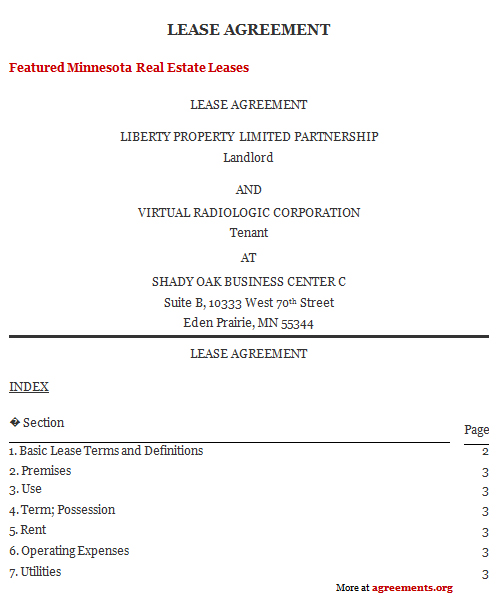What Is a Minnesota Lease Agreement?
A Minnesota lease agreement is a written document signed by a landlord and a tenant. The landlord agrees to allow the tenant to use the described property for the timeframe listed in the lease. The tenant agrees to pay a certain amount each month to use the premises and be entitled to Minnesota rental rights. All Minnesota lease agreements must comply with the Minnesota landlord-tenant law. The most commonly used Minnesota lease agreements are commercial lease agreements, Minnesota standard residential leases, month-to-month leases, a lease to buy deal, and a roommate agreement.
Who Are the Parties to a Minnesota Lease Agreement?
In the purest form of the Agreement, there are only two parties to the agreement.
- The tenant/lessee: He/she is the person who gets into an agreement to live in the Minnesota houses for rent owned by the landlord and pay a stipulated amount for it each month.
- The owner/lessor: He/she is the person who owns the property and who allows the tenant to live in the park for a specific timeframe.
Purpose of a Minnesota Lease Agreement
The sole purpose of this agreement is to bind a Lessor and Lessee to the terms and conditions contained within. This was done by means of having each party sign this document as of a certain date. Several aspects of such a contract will have to be fully discussed between these two parties before entering this lease.
Key Terms of a Minnesota Lease Agreement
A Minnesota Lease Agreement consists of the following:
- The legal name of each tenant who will sign the lease, the full name of anyone who will reside on the property, but who isn’t signing the lease (the most common example is a minor child) and the legal name of the landlord.
- The street address, city, state, and zip code of the rental unit.
- The length of the lease, including the starting date and the ending date. The starting date is referred to as the starting date of possession. The ending date is referred to like the ending date of possession.
- The amount of rent that the tenant will pay each month as well as when and how the rent should be paid.
- The amount of money paid as a security deposit.
- The amount of a late fee that will be assessed if the rent isn’t paid on time and any other fees, such as an NSF fee, the tenant will be required to pay.
How to Draft the Drafting a Minnesota Lease Agreement?
An effective Minnesota lease agreement can be drafted using the following guidelines:
- Familiarize yourself with your state’s laws. Property management and real estate laws differ depending on what state and even city you live in. Research your region’s laws by consulting a lawyer.
- Write an explicit and easy-to-understand contract such that both parties will understand and abide by it. This ensures that the terms are understood and abided by and that in the event of a dispute, they will hold up in court.
- Include all the stipulations that are required. The lease agreement can include a wide range of stipulations, including a pet policy, what installations can be made, who covers what repairs, and penalties for late payments. The more specific the stipulations are, the less chance of having to face disputes in the future.
- Include details regarding the deposit. One of the most common disputes between landlords and tenants is the return of the security deposit. Clearly explain what damages will prevent the tenant from receiving his/her security deposit back at the end of the lease.
Benefits and Drawbacks of a Minnesota Lease Agreement
The advantages are:
- Balanced cash outflow: the biggest advantage of leasing is that cash outflow or payments related to leasing are spread out over several years, hence saving the burden of one-time significant cash payment. This helps a business to maintain a steady cash-flow profile.
- Quality assets: While leasing an asset, the ownership of the asset still lies with the lessor, whereas the lessee just pays the rental expense. Given this agreement, it becomes plausible for a business to invest in good quality assets, which might look unaffordable or expensive otherwise.
The disadvantages are:
- Lease expenses: Lease payments are treated as expenses rather than as equity payments towards an asset.
- Processing and documentation: Overall, to enter into a lease agreement is a complex process and requires thorough documentation and proper examination of an asset being leased.
What Happens in Case of Violation?
Under the Minnesota laws, in case there is a violation of the lease agreement, the tenant and the owner can break the lease stipulating their reasons for the same. A Minnesota eviction notice form may also be filed to evict the tenant.
The Minnesota lease agreement is as effective as any other lease agreement in providing clarity and security to the tenant as well as the owner of the property being leased, which helps in avoiding any legal disputes. At the end of the stipulated period mentioned in the agreement, the tenant also has a right to buy the property if he/she wishes to be a great investment thus. In case any dispute arises, it can be solved with the help of a legal suit or meditation sessions.
Sample Minnesota Lease Agreement
A sample of the Minnesota Lease agreement can be downloaded from below.
